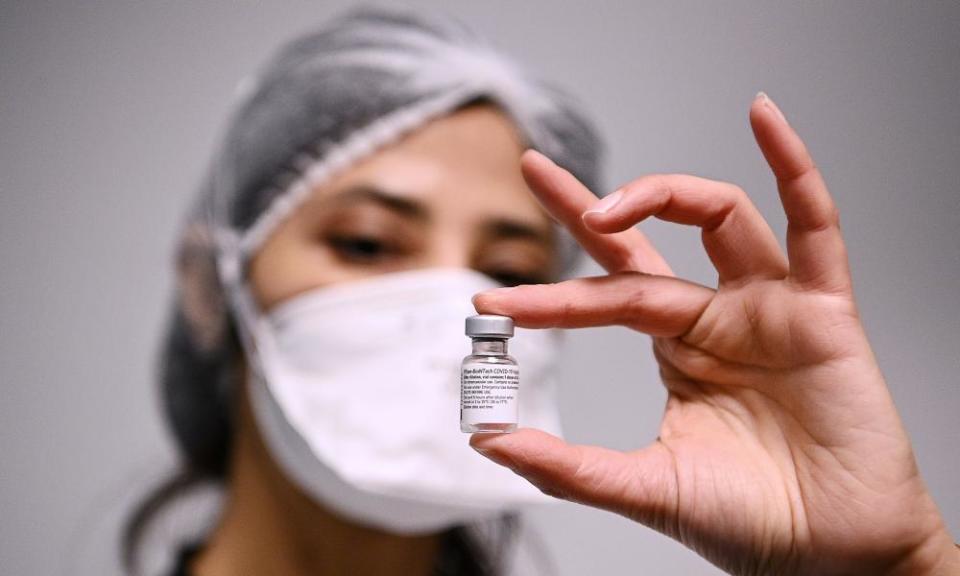Is Covid-19 on the run in the UK?

John Edmunds has been at the centre of the unravelling of the Covid-19 pandemic since cases first appeared in January 2020. A member of Sage, the government’s scientific advisory group, and a professor of epidemiology at the London School of Hygiene & Tropical Medicine, he has consistently warned ministers about the threats posed by the disease.
These risks have often been clear in their nature. But today, 18 months after Covid-19 first appeared, he believes the nation stands at a point of maximum uncertainty about the future of the pandemic.
“At any other point of the epidemic, it has been easier to foresee what might happen,” he told the Observer. “But at this point, I think it’s really hard to understand what has happened and what is going to happen in the long term. There is a huge amount of uncertainty about the disease at the moment.”
The fact that we are a year and a half into the pandemic and are still being wrongfooted by Covid-19 may seem surprising. After all, in that time, we have developed powerful vaccines to protect against it and have pinpointed critically important drugs to treat patients. Science has worked wonders.
Watch: 84,938,000 jabs now given in the UK
Nevertheless, researchers are still very unsure about how Covid-19 will progress in the UK in the coming months.
The statistics have certainly been startling. First, case numbers rocketed at the beginning of July. Then they reversed and began to fall, leaving statisticians and scientists struggling to make sense of the fluctuating figures. For good measure, a host of conflicting factors has been put forward to explain Covid case numbers.
Has the opening up of society on 19 July had a major impact? Did Euro 2020 propel the virus through the homes and pubs of England? Could the UK be approaching herd immunity? And what impact have the school holidays had on the progress of the disease?
Untangling these factors, as well as understanding the exact impact vaccines have had on society, has now become a complex, urgent business. “It will tell us just how bad things are likely to get when society really opens up in September and October and as winter approaches,” said Edmunds.
There is clear agreement on one factor, however. All the evidence indicates that vaccines are now playing a pivotal role in controlling the disease. Had the government completely opened society on an unprotected populace, daily death tolls would by now have soared into their thousands. But just how far has our vaccine protection reached?
It is a crucial question, whose answer will determine just how severe will be the return of Covid-19 in the autumn as schools reopen, the weather chills and people head indoors. A key factor is the degree to which the country has achieved herd immunity. In other words, will we have reached the point where so many people have been either infected or vaccinated – and therefore possess some immunity to the disease – that viral transmission falls or even stops?
“You can run some very simple models to see if the case numbers that we saw earlier this month are consistent with effective herd immunity,” said Prof Mark Woolhouse of Edinburgh University. “And in my view the answer is, yes, it is. There are some big caveats but the bottom line is that those figures are consistent with the impact of herd immunity.”
Woolhouse pointed to a recent Office of National Statistics survey which showed that around 90% of adults in the UK now possessed Covid antibodies, which indicates that they could be capable of some kind of immune response to infection. “That is a very large fraction and it may well be having an impact,” he said.

Prof Martin Hibberd, also of the London School of Hygiene and Tropical Medicine, agreed that herd immunity was becoming a realistic prospect. “We are approaching herd immunity but I don’t think we’re quite there yet,” he said.
But if we are nearing this sought-after goal, why was there such a rapid rise in cases in mid-July? What circumstances could have triggered this massive leap in infections in a nation that is supposed to be heading towards herd immunity? Scientists point to two key factors: the Euros and schools closing for the holidays.
“If you look at herd immunity, you would expect it to peak at different times in different parts of the country as there are differing levels of immunity across the country,” said Edmunds. “But this is not what we saw: we saw a synchronous drop in cases right across England. This suggests an external factor was behind it – something that occurred across the country at the same time.”
And the two most likely candidates, he said, are schools closing and the “pingdemic” that occurred immediately after the Euros. In other words, the large gatherings of fans – mostly male – in pubs to watch England play football would have triggered jumps in case numbers in mid-July. This would have been followed by a rise in contacts being asked to self-isolate after being linked to infected fans.
“This bout of self-isolation occurred across the country at the same time, and it looks like it reduced cases,” Edmunds said. “But these would be expected to go up again – if were not for the effect of school closures.
“Pupils are no longer bringing home viruses after picking them up in class. This is now probably helping to hold cases down, and may well do so over the summer.”
Prof Martin HibberdWe are approaching herd immunity, but I don't think we're quite there yet
This point was backed by Woolhouse. “We are now three and a half weeks past our peak in Scotland, and numbers are still not going back up. So, you know, I’m more confident that the underlying trend is in the right direction.”
Prof James Naismith, director of the Rosalind Franklin Institute in Oxford, also thinks the short-term picture is optimistic. “It looks as if case numbers are plateauing, and one would hope they will drop somewhat over summer,” he said.
However, problems will return in September when children go back to school, businesses open up and people spend more time indoors.
“We will still have high levels of infection in the community. About one person in 65 carries the virus at present, and that means virus levels are not going to go down significantly by September,” Naismith said. “Under those circumstances, the virus will have a good platform from which to start infecting those who are unprotected when conditions make it more favourable for it to spread.”
This point was backed by virologist Stephen Griffin of Leeds University. “I am worried that even if case numbers continue to go down, they will start to come back up again with a vengeance in September when the schools go back.”
One solution proposed by Naismith is to vaccinate 16- and 17-year-olds across the UK. That would protect them from Covid-19 complications, which are worse than any vaccine complications they might encounter. It would also push the population closer to the level it needs to achieve herd immunity.
“I think we are close to that immunity but will not be quite there by autumn,” he added. “So we should be thinking about whether or not to vaccinate 16- and 17-year-olds. That would help us achieve wider protection against the virus. In any case, teenagers are perfectly capable of making up their own minds about the risks and benefits involved in being vaccinated. After all, 16-year-olds in Scotland are allowed to vote.”
Two further vexing issues bedevil attempts to clarify the nation’s route out of the pandemic: new variants and possible fading vaccine efficacy. The danger posed by new variants concern is raised by Jeremy Farrar, director of the Wellcome Trust, in Spike: The Virus v the People, his new book about the pandemic. High infection rates raise the chances of a new variant being cooked up, he argues. “That is very probably why the variants of concern have been traced to countries like the UK, South Africa and Brazil, which have had poorly controlled transmission.”
These fears are echoed by Hibberd. “It is possible that, with luck, the virus will not be able to mutate sufficiently to enable it to escape the immunity being provided by vaccines or previous infections,” he told the Observer. “Nevertheless, the appearance of an immunity-evading virus is a distinct possibility. After all, it happens with other viruses, like influenza. We have to create new vaccines against flu every year, and it mutates and comes back the next year slightly changed, and we then have to develop a new vaccine to tackle it.”
At present, scientists and pharmaceutical companies are working on vaccines to tackle some of the new variants that have appeared over the past year. For example, the Oxford vaccine team led by Dame Sarah Gilbert is working on one for the beta variant, first discovered in South Africa, which is considered to be the one with the greatest potential to evade vaccines.

And then there is the issue of vaccine efficacy. Studies have shown that Covid-19 antibodies decrease over time in vaccinated individuals. This may limit people’s protection against the virus.
A study published last week indicated that the efficacy of the Pfizer vaccine declines by an average of 6% every two months. Findings such as these suggest that the government may have to set up a programme of booster vaccine shots for the over-50s to strengthen their protection over the winter.
These fears were highlighted last month by the Academy of Medical Sciences in its report, Covid-19: Preparing for the Future. “We are going to go into this winter and start mixing again in ways that we didn’t do last year,” said Dame Anne Johnson, president of the academy. “In those circumstances, we can expect to see a real upsurge in respiratory infections such as flu, which we may have waning immunity against because we were not exposed to it last year.
Related: UK can expect thousands of Covid deaths every year, warn scientists
“In addition, the Office of National Statistics estimated, in its last report, that a total of 856,200 people in England were infected with the Covid virus during the week ending 24 July. That is a very big number.
“So whether overall figures go up or down slightly, the current situation is that we’ve got an awful lot of infection around with a very transmissible variant. So the take-home message is clear: this pandemic has not yet gone away.
“Exactly how it plays out is a different matter. There are so many variables involved. Indeed the only thing that is clear is that the situation is very uncertain.”

 Yahoo Finance
Yahoo Finance 